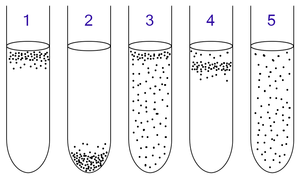
Back بكتيريا لاهوائية إجبارية Arabic বাধ্যতামূলক অবায়বীয় Bengali/Bangla Anaerobi obligat Catalan Anaerobio hertsi Basque بیهوازی اجباری Persian Anaerobio obrigado Galician אל-אווירני אובליגטורי HE अविकल्पी अवायुजीव Hindi 절대혐기성 미생물 Korean Anaerob obligatoryjny Polish

1: Obligate aerobes need oxygen because they cannot ferment or respire anaerobically. They gather at the top of the tube where the oxygen concentration is highest.
2: Obligate anaerobes are poisoned by oxygen, so they gather at the bottom of the tube where the oxygen concentration is lowest.
3: Facultative anaerobes can grow with or without oxygen because they can metabolise energy aerobically or anaerobically. They gather mostly at the top because aerobic respiration generates more ATP than either fermentation or anaerobic respiration.
4: Microaerophiles need oxygen because they cannot ferment or respire anaerobically. However, they are poisoned by high concentrations of oxygen. They gather in the upper part of the test tube but not the very top.
5: Aerotolerant organisms do not require oxygen and cannot utilise it even if present; they metabolise energy anaerobically. Unlike obligate anaerobes, however, they are not poisoned by oxygen. They can be found evenly spread throughout the test tube.
Both facultative anaerobes and aerotolerant organisms will undergo fermentation in the absence of oxygen, but the facultative anaerobes will switch to aerobic metabolism when oxygen is present (a phenomenon known as the Pasteur effect). The Pasteur effect is sometimes used to distinguish between facultative anaerobes and aerotolerant organisms, in the lab.
Obligate anaerobes are microorganisms killed by normal atmospheric concentrations of oxygen (20.95% O2).[1][2] Oxygen tolerance varies between species, with some species capable of surviving in up to 8% oxygen, while others lose viability in environments with an oxygen concentration greater than 0.5%.[3]
- ^ Prescott, Lansing M.; Harley, John P.; Klein, David A. (1996). Microbiology (3rd ed.). William C Brown Pub. pp. 130–131. ISBN 0-697-29390-4.
- ^ Brooks, Geo F.; Carroll, Karen C.; Butel, Janet S; Morse, Stephen A. (2007). Jawetz, Melnick & Adelberg's Medical Microbiology (24th ed.). McGraw Hill. pp. 307–312. ISBN 978-0-07-128735-7.
- ^ Ryan, Kenneth J.; Ray, C. George, eds. (2004). Sherris Medical Microbiology (4th ed.). McGraw Hill. pp. 309–326, 378–384. ISBN 0-8385-8529-9.
© MMXXIII Rich X Search. We shall prevail. All rights reserved. Rich X Search